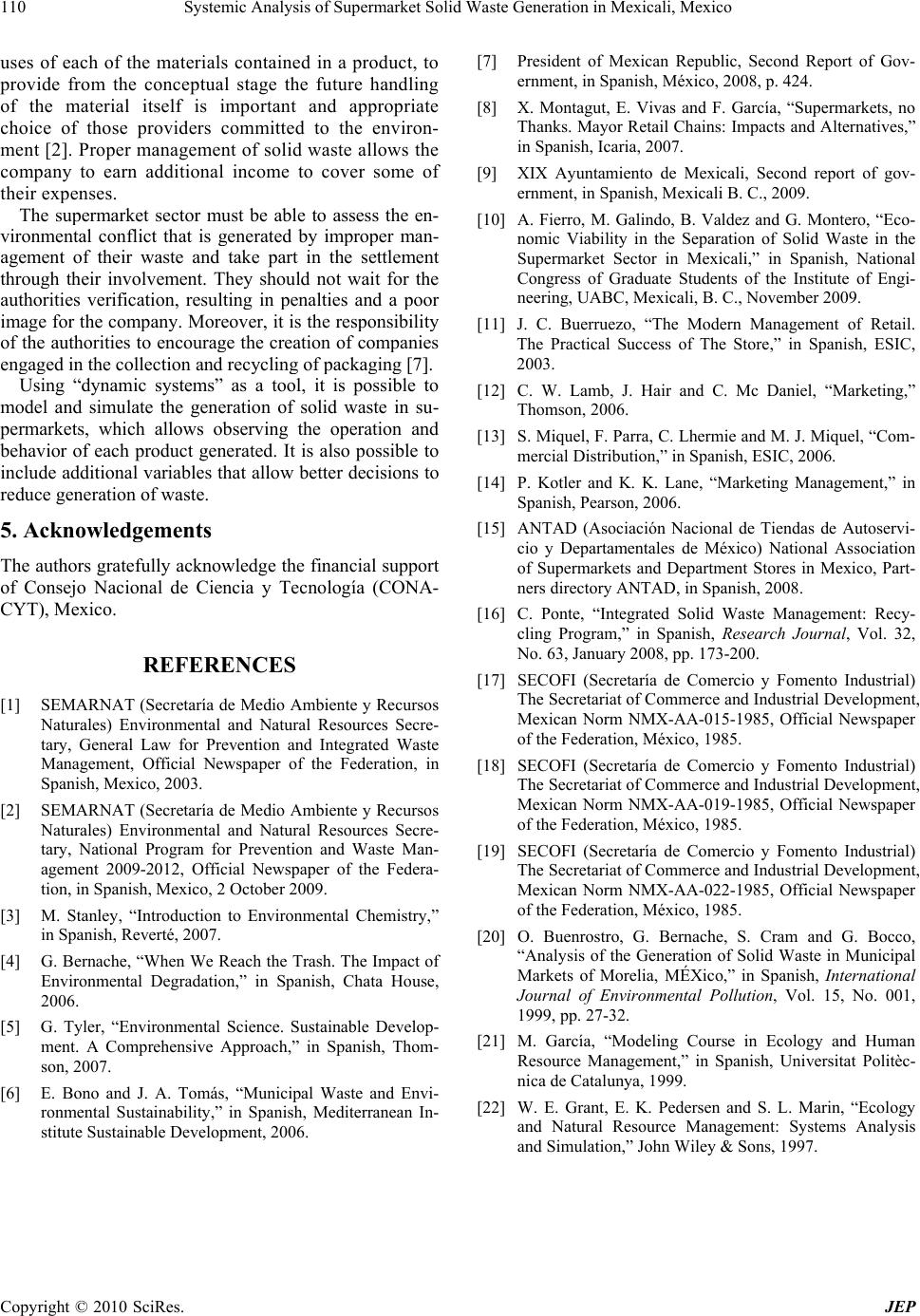
Systemic Analysis of Supermarket Solid Waste Generation in Mexicali, Mexico
110
uses of each of the materials contained in a product, to
provide from the conceptual stage the future handling
of the material itself is important and appropriate
choice of those providers committed to the environ-
ment [2]. Proper management of solid waste allows the
company to earn additional income to cover some of
their expenses.
The supermarket sector must be able to assess the en-
vironmental conflict that is generated by improper man-
agement of their waste and take part in the settlement
through their involvement. They should not wait for the
authorities verification, resulting in penalties and a poor
image for the company. Moreover, it is the responsibility
of the authorities to encourage the creation of companies
engaged in the collection and recycling of packaging [7].
Using “dynamic systems” as a tool, it is possible to
model and simulate the generation of solid waste in su-
permarkets, which allows observing the operation and
behavior of each product generated. It is also possible to
include additional variables that allow better decisions to
reduce generation of waste.
5. Acknowledgements
The authors gratefully acknowledge the financial support
of Consejo Nacional de Ciencia y Tecnología (CONA-
CYT), Mexico.
REFERENCES
[1] SEMARNAT (Secretaría de Medio Ambiente y Recursos
Naturales) Environmental and Natural Resources Secre-
tary, General Law for Prevention and Integrated Waste
Management, Official Newspaper of the Federation, in
Spanish, Mexico, 2003.
[2] SEMARNAT (Secretaría de Medio Ambiente y Recursos
Naturales) Environmental and Natural Resources Secre-
tary, National Program for Prevention and Waste Man-
agement 2009-2012, Official Newspaper of the Federa-
tion, in Spanish, Mexico, 2 October 2009.
[3] M. Stanley, “Introduction to Environmental Chemistry,”
in Spanish, Reverté, 2007.
[4] G. Bernache, “When We Reach the Trash. The Impact of
Environmental Degradation,” in Spanish, Chata House,
2006.
[5] G. Tyler, “Environmental Science. Sustainable Develop-
ment. A Comprehensive Approach,” in Spanish, Thom-
son, 2007.
[6] E. Bono and J. A. Tomás, “Municipal Waste and Envi-
ronmental Sustainability,” in Spanish, Mediterranean In-
stitute Sustainable Development, 2006.
[7] President of Mexican Republic, Second Report of Gov-
ernment, in Spanish, México, 2008, p. 424.
[8] X. Montagut, E. Vivas and F. García, “Supermarkets, no
Thanks. Mayor Retail Chains: Impacts and Alternatives,”
in Spanish, Icaria, 2007.
[9] XIX Ayuntamiento de Mexicali, Second report of gov-
ernment, in Spanish, Mexicali B. C., 2009.
[10] A. Fierro, M. Galindo, B. Valdez and G. Montero, “Eco-
nomic Viability in the Separation of Solid Waste in the
Supermarket Sector in Mexicali,” in Spanish, National
Congress of Graduate Students of the Institute of Engi-
neering, UABC, Mexicali, B. C., November 2009.
[11] J. C. Buerruezo, “The Modern Management of Retail.
The Practical Success of The Store,” in Spanish, ESIC,
2003.
[12] C. W. Lamb, J. Hair and C. Mc Daniel, “Marketing,”
Thomson, 2006.
[13] S. Miquel, F. Parra, C. Lhermie and M. J. Miquel, “Com-
mercial Distribution,” in Spanish, ESIC, 2006.
[14] P. Kotler and K. K. Lane, “Marketing Management,” in
Spanish, Pearson, 2006.
[15] ANTAD (Asociación Nacional de Tiendas de Autoservi-
cio y Departamentales de México) National Association
of Supermarkets and Department Stores in Mexico, Part-
ners directory ANTAD, in Spanish, 2008.
[16] C. Ponte, “Integrated Solid Waste Management: Recy-
cling Program,” in Spanish, Research Journal, Vol. 32,
No. 63, January 2008, pp. 173-200.
[17] SECOFI (Secretaría de Comercio y Fomento Industrial)
The Secretariat of Commerce and Industrial Development,
Mexican Norm NMX-AA-015-1985, Official Newspaper
of the Federation, México, 1985.
[18] SECOFI (Secretaría de Comercio y Fomento Industrial)
The Secretariat of Commerce and Industrial Development,
Mexican Norm NMX-AA-019-1985, Official Newspaper
of the Federation, México, 1985.
[19] SECOFI (Secretaría de Comercio y Fomento Industrial)
The Secretariat of Commerce and Industrial Development,
Mexican Norm NMX-AA-022-1985, Official Newspaper
of the Federation, México, 1985.
[20] O. Buenrostro, G. Bernache, S. Cram and G. Bocco,
“Analysis of the Generation of Solid Waste in Municipal
Markets of Morelia, MÉXico,” in Spanish, International
Journal of Environmental Pollution, Vol. 15, No. 001,
1999, pp. 27-32.
[21] M. García, “Modeling Course in Ecology and Human
Resource Management,” in Spanish, Universitat Politèc-
nica de Catalunya, 1999.
[22] W. E. Grant, E. K. Pedersen and S. L. Marin, “Ecology
and Natural Resource Management: Systems Analysis
and Simulation,” John Wiley & Sons, 1997.
Copyright © 2010 SciRes. JEP